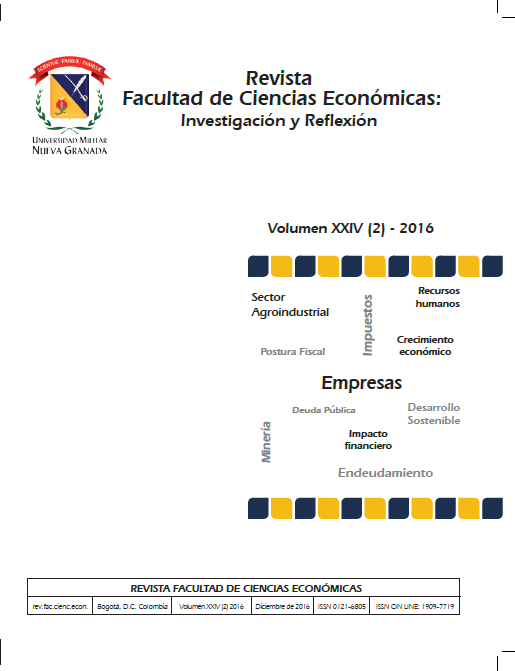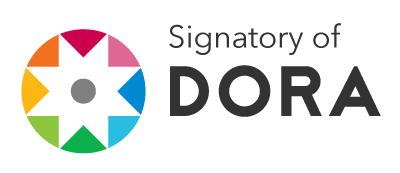Human resources under the approach of the theory of resources and capabilities
Abstract
In this work an exploration of the theory of Resources and Capabilities is presented, recognizing the importance of the Strategy and Competitive Advantage. Highlighting that businesses´ success is given when its resources and capabilities are identified and exploited when they are observed as a potential single value. Nowadays companies face global markets; finding a competitive advantage may represent their survival. The methodology of this document is based on the review of published papers related to the subject of human resources. Among the findings it is emphasized that organizations seek new creative ways to work with competent human resources that help create competitive advantage in order to serve the dynamic environment and generate innovationsDownloads
References
Alles, M. (2004). Dirección estratégica de recursos humanos: gestión por competencias. Casos. Argentina: Ediciones Garnica.
Amit, R., & Schoemaker, P. (1993). Strategic Assets and Organizational Rent. Strategic Management Journal, 14: 33-46. http://dx.doi.org/10.1002/smj.4250140105
Arnoletto, J. (2007). La Tecnología como instrumento de desarrollo. En: Arnoletto, J. El impacto de la tecnología en la transformación del mundo (págs. 1-142). Obtenido de: www.eumed.net/libros/2007c/333
Barney, J. (1986). Strategic factor markets: expectations, luck, and business strategy. Management Science, 32(10): 1231-1241. http://dx.doi.org/10.1287/mnsc.32.10.1231
Barney, J. (1991). Firm resources and sustained competitive advantage. Journal of Management, 17(1): 99-120. http://dx.doi.org/10.1177/014920639101700108
Barney, J. (2001). Is the resource-based "view" a useful perspective for strategic management research? Yes. Academy of Management Review, 26(1): 41-56.
Bisquerra, R. & Pérez, N. (2007). Las competencias emocionales. Educación XXI, 10: 61-82. http://dx.doi.org/10.5944/educxx1.1.10.297
Boudreau, J. (1983). Economic considerations in estimating the utility of human resource productivity improvement programs. Personnel Psychology, 36(3), 551-5576. doi:10.1111/j.1744-6570.1983.tb02235.x
Brunner , J. (2000). Globalización y el futuro de la educación: tendencias, desafíos y estrategias . Disponible en: http://www.schwartzman.org.br/simon/delphi/pdf/brunner.pdf
Burns, T. & Stalker, G. (1961). The management of innovation. London: Tavistock.
Calderón, G., Naranjo, J. C., & Álvarez, C. M. (2010). Gestión humana en la empresa colombiana: sus características, retos y aportes. Una aproximación a un sistema integral. Cuardenos de Administración, 23(42), 13-16.
Capelli, P. & Singh, H. (1992). Integrating strategic human resources and strategic management. En: Lewin, D., Mitchell, O. & Sherer, P. (Eds.) Research frontiers in industrial relations and human resources, 165-192. Madison, WI: IRRA.
Cardona , R. (2011). Estrategia basada en los recursos y capacidades criterios de evaluación y el proceso de desarrolo . Revista electrónica forum doctoral, (4): 113-147.
Chan, L., Shaffer, M., & Shape, E. (2004). In search of sustained competitive advantage: the impact of organizational culture, competitive strategy and human resource management practices on firm performance. The International Journal of Human Resource Management, 15(1), 17-35. doi:10.1080/0958519032000157320
Corominas, J. (1987). Breve Diccionario Etimológico de la Lengua Castellana. Madrid: Gredos.
Dierickx, I., & Cool, K. (1989). Asset Stock Accumulation and Sustainability of Competitive Advantage. Management Sciencie, 35(12): 1504-1513. http://dx.doi.org/10.1287/mnsc.35.12.1504
Edvinsson, L. & Malone, M. (1997). Intellectual Capital. Piatkus, London.
Eisenhardt, K. & Martin, J. (2000). Dynamic capabilities: what are they? En: Strategic Management Journal, 21: 1105–1121. http://dx.doi.org/10.1002/1097-0266(200010/11)21:10/11<1105::AID-SMJ133>3.0.CO;2-E
Eraut, M. (1994). Developing professional knowledge and competence, London: Falmer Press.
Fong, C. (2011). La teroría de los recursos y capacidades: Un enfoque contemporáneo en la gestión empresarial. (U. d. Guadalajara, Ed.) Carta Económica Regional, (61): 27-31.
Goleman, D. (2004). La inteligencia emocional. México: Javier Vergara Editor.
González, C. & Martínez, J. (2014). Gerencia estratégica e innovación empresarial: referentes conceptuales. Revista Dimensión Empresarial, 12(1): 107-116. http://dx.doi.org/10.15665/rde.v12i2.282
Grant, R. (1991). The resource-based theory of competitive advantage implication for estrategy formulation. California Management Review: 114-135. http://dx.doi.org/10.2307/41166664
Grant, R. (1996). Prospering in Dynamically Competitive Enviroments: Organizational Capability as Knowledge Integration. Organization Science, 7(4): 375-387. http://dx.doi.org/10.1287/orsc.7.4.375
Hager, P. (1998). Recognition of informal learning: challenges and issues. Journal of Vocational Education and Training, 50 (4): 521-535. http://dx.doi.org/10.1080/13636829800200070
Hamel, G., & Prahalad, C. (1989). To revitalize corporate performance we need, a whole new model strategy. Strategy Intent. Harvard Business Review, 63-76.
Hamel, G., & Prahalad, C. (1990). The core competence of the corporation. Harvard business review: 79-91.
Harrison, M. (1987). Diagnosing Organizations. Methods, Models, and Processes. Sage Publications, Newburry Park.
Helfat, C. & Peteraf, M. (2009). Understanding dynamic cpabilities: progress along a develpmental path. Strategic Organization, 7: 91-102. doi:10.1177/1476127008100133
Hitt, M., Bierman, L., Shimizu, K. & Kochar, R. (2001). Direct and Moderating Effects of Human Capital on Strategy and Performance in Professional Service Firms: A Resource-Based Perspective. Academy of Management, 44 (1): 13-28. doi: 10.2307/3069334
Hofer, C., & Schendel, D. (1978). Company, Chapter 2. En: Hofer, C. & Schendel, D. Strategy Formulation Analytical Concepts (pp. 12-45). South Western.
Hoopes, D., Madsen, T. & Walker, G. (2003). Guest editors' introduction to the specialissue: why is there a resource-based view?toward a theory of competitiveheterogeneity. Strategic Management Journal, 24: 889–902. doi: 10.1002/smj.356
Instituto Nacional para la Evaluación de la Educación - INEE (2014). Sistema Educativo Estatal de Baja California . Obtenido de Sistema Educativo Estatal de Baja California : http://www.educacionbc.edu.mx/departamentos/evaluacion/descargas/Archivos/PISA_docentes.pdf
Mahoney, J. (1995). The management of resources and the resource of management. Journal of Business Research, 33: 91-101. http://dx.doi.org/10.1016/0148-2963(94)00060-R
McClelland, D. (1973). Testing for competence rather than for 'intelligence'. American Psychologist, 28 (1): 423-447. http://dx.doi.org/10.1037/h0034092
McClelland, D. (1998). Identifying competencies with behavioural-event interviews. Psychological Science, 9 (5): 331-339. http://dx.doi.org/10.1111/1467-9280.00065
Mulder, M., Weigel, T. & Collings, K. (2008). El concepto de competencia en el desarrollo de la educación y formación profesional en algunos Estados miembros de la Unión Europea: un análisis crítico. Disponible en: http://www.ugr.es/~recfpro/rev123ART6.pdf
Nielsen, A. (2006). Undertanding Dynamic Capabilities Through Knowledge Management. Journal of Knowledge Management, 10(4): 59-71. http://dx.doi.org/10.1108/13673270610679363
Norris , N. (1991). The trouble with competence. Cambridge Journal of Education, 12(3), 331-341. http://dx.doi.org/10.1080/0305764910210307
Ortiz, M. & Avellana, L. (2002). Gestión Estratégica de los Recursos Humanos:. Investigaciones Europeas de Dirección y Economía de la Empresa, 59-78.
Parra, C., & Toro, I. (2014). Revisión del concepto de desarrollo estratégico del recurso humano desde el análisis de la literatura. Suma de Negocios, 5(11): 108-116. http://dx.doi.org/10.1016/S2215-910X(14)70025-4
Pérez, N. (2001). Proyecto docente para la obtención de la palza de profesora titular. Barcelona: Universidad de Barcelona.
Pérez, E. & Toro, I. (2015). Capacidades de absorción: ¿dónde estamos ahora y dónde queremos estar en el furturo? Espacios, 36(11).
Peteraf, M. (1993). The conerstones of competitive advantage: A resource-based view. Strategic Management, 14(3): 179-191. http://dx.doi.org/10.1002/smj.4250140303
Porter , M. (1991). Towards a dynamic theory or strategy. Management Journal, 12: 95-117. http://dx.doi.org/10.1002/smj.4250121008
Rialp, A. (2003). Fundamentos teóricos de la Organización de Empresas. Madrid: Pirámide.
Rodríguez, L. M. (2005). Herramienta para medición de las competencias genéricas de los futuros ingenieros respecto de las relaciones interpersonales. Revista de Informática Educativa y Medios Audiovisuales, 2(6): 7-16.
Rugman, A. & Verbeke, A. (2002). Edith Penrose´s contribution to the resource-based view of strategic management. Strategic Management Journal, 23: 769-780. doi:10.1002/smj.240
Rumelt, R. (1984). Towards a strategic theory of the firm. En: Lamb, R. (Ed.). Competitive strategic management. Prentice-Hall, Englewood Cliffs (NJ).
Stadler, C. (2007). The 4 principles of enduring success. Harvard business review: 62-72.
Shahibudin, I. (2015). Career success studies: An examination of indicators, approach and underlying. Theories in Literature. Science Journal, 3(6), 251-257. doi:10.11648/j.sjbm.20150306.16
Teece, D. (1982). Towards an economic theory of the multiproduct firm. Journal of Economic Behavior & Organization , 39-63. http://dx.doi.org/10.1016/0167-2681(82)90003-8
Teece, D. & Pisano, G. (1994). The dynamic capabilities of firms: an introduction. Industrial and Corporate Change, 3(3): 537-556. http://dx.doi.org/10.1093/icc/3.3.537-a
Teece, D., Pisano, G. & Shuen, A. (1997). Dynamic Capabilities and Strategic Management. Strategic Management Journal, 18(7): 509-533. http://dx.doi.org/10.1002/(SICI)1097-0266(199708)18:7<509::AID-SMJ882>3.0.CO;2-Z
Tobón, S. (2004). Formación basada en competencias. Disponible en: http://www.urosario.edu.co/CGTIC/Documentos/aspectos_basicos_formacion_basada_competencias.pdf
Torres, L. & Díaz, J. (2010). Organizaciones basadas en inteligencia: aproximación a una realidad del siglo XXI. Revista científica teorías enfoques y aplicaciones en las ciencias sociales(5), 117-127.
Wesselink, R., Biemans, H., van den Elsen, E. & Mulder, M. (2005). Conceptual framework for competence-based VET in the Netherlands. Disponible en: http://www.vet-research.net/ecer_2005/fri09/session7a/P20050000789/
Wernerfelt, B. (1984). A resource-based view of the firm. Strategic Management Journal, 5: 171-180. http://dx.doi.org/10.1002/smj.4250050207
Wright, P., Dunford, B. & Snell, S. (2001). Human resources and the resource based view for the firm. Journal of Management, 27: 701-721. doi:10.1177/014920630102700607
Zollo, M. & Winter, S. (2002). Deliberate Learning and the Evolution of Dynamic Capabilities. Organization Science, 13 (3): 339 – 351. DOI: http://dx.doi.org/10.1287/orsc.13.3.339.2780











